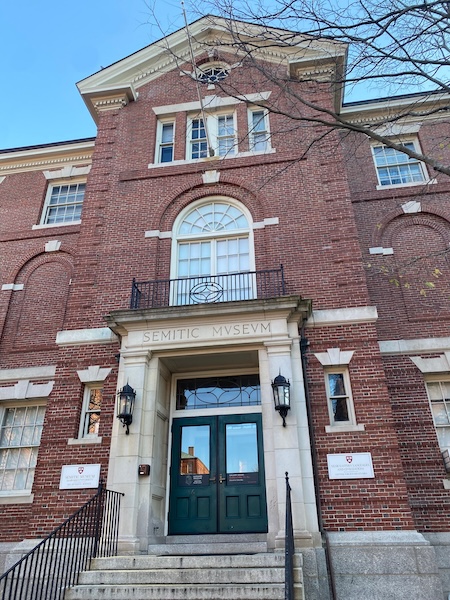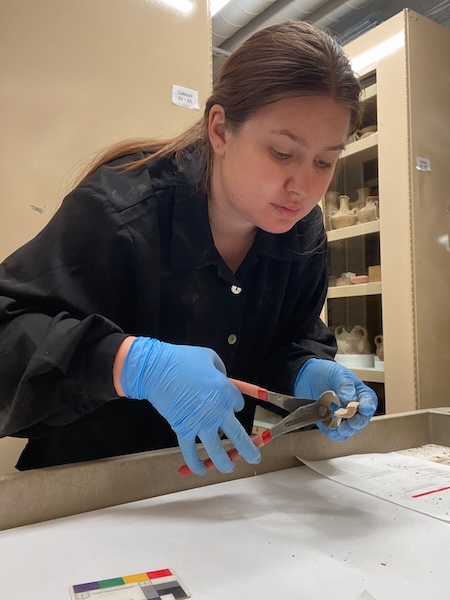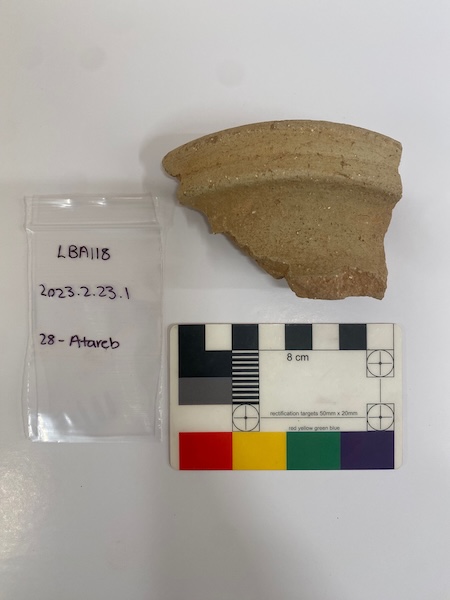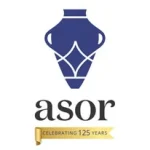
2024 Collections Fellowship Report: The Land Behind Aleppo: Urban Life and State Formation in Bronze Age Syria
Holly Winter, University of Sydney
Thanks to an ASOR Study of Collections Fellowship, I was able to spend a week in Boston at the Harvard Museum of the Ancient Near East (HMANE), studying the ASOR Syrian Survey material. The focus of the research trip was to study the ceramic assemblage collected as part of the 1970s ASOR Syrian Survey (ASS) project by the late James Sauer. This research forms part of a larger project, the ‘Land Behind Aleppo’ (LBA) project, which aims to investigate the Bronze Age history of Aleppo, specifically during the time of the powerful Middle Bronze Age (MBA) kingdom of Yamkhad (Aleppo). It employs legacy ceramic assemblages collected by James Sauer, as part of his ASOR Syrian Survey. This will be combined with the late John Matthers’ River Qoueiq survey project materials, now housed at the Institute of Archaeology at University College London. The ‘Land Behind Aleppo’ project aims to investigate Aleppo’s Bronze Age history through a ceramic proxy study of the central city’s changing pattern of relationships with its hinterland settlements over the course of the Bronze and Iron Ages, aiming to bracket the period of greatest prominence (the MBA: 2000-1500 BCE) and evaluating the changing fortunes of Aleppo down the ages. As fieldwork in the region of Aleppo in the near future is unlikely, this research is a necessary precursor and eventual supplement to any future work on the central site and its region.

Analysing ceramics from a number of sites in the hinterland regions of Aleppo will aim to chart the development and changing pattern of interaction between the various settlements within the polity of Yamkhad over time. Key to this study is tracking the expansion and contraction of the central state’s economic ‘footprint’. A multi-proxy analytical programme using a combination of typological approaches and scientific techniques, drawn from geochemistry, petrography, and materials science, will target select ceramic forms, chosen because they potentially inform on different aspects of contact. These well-established methods can illuminate the production and distribution of storage/transport jars associated with bulk commodity transactions such as those involving grain and oil for trade/taxation, fine tablewares for elite consumption/emulation studies, and cooking/food preparation forms indicative of local production. Together these enable us to examine and hopefully contrast what is locally, sub-regionally, and centrally produced. The resulting data informs on trade, administration, and systems of production and distribution. The ‘reach’ of the central site, and thus arguably its politico-economic power projection, will be assessed over time. The ultimate aim is to chart the ebb and flow of influence/power, and whether this is primarily elite-interaction driven, or staple-economic in form.

The numerous boxes of ceramics from the ASOR Syrian Survey (ASS) sites were made available for this study thanks to Dr. Adam Aja, Chief Curator at the HMANE. The ASOR Syrian Survey was conducted by James Sauer from 1977-79, and studied 83 sites across Syria. The collection is large and multi-period in scope, now stored in 24 boxes in the HMANE. Only sites with materials from the Bronze and Iron Ages were studied as part of this research project. The aim during this visit to the HMANE was to gather ceramics from the Aleppo Sector of the ASS collection, as time was limited. In total, I was able to sample 11 sites in three days, focussing on sites closest to Aleppo. Before sampling, each site assemblage was reviewed, and then a selection of sherds were chosen for sampling. The choice of which sherds to sample was based on a pre-established typology, although size of sherd and appropriateness for sampling were considerations. Each sherd was given a project number (LBA#), described and sketched before sampling. It was then photographed with site identifiers and a second time on both obverse and reverse surfaces, and occasionally the profile. Approximately a half cm size was snipped from the sherd at a location that would not impact future drawing of the sherd (mostly from the shortest profile side). A total of 175 sherds were sampled during this visit to the HMANE, and it is hoped that petrography and neutron-activation analysis will be able to be conducted on these samples in the near future.

The ASS material will offer insights into the social and economic history of a region where little is currently known, in the hope that results pertaining to the pre-eminent MBA kingdom of Yamkhad can be generalized across the Levant, and perhaps further afield. It also exploits an important legacy database that has been unstudied for nearly 50 years, giving promise of shedding light on one of the main drivers of Syrian urban life in the MBA and beyond–Aleppo.
Latest Posts from @ASORResearch
Stay updated with the latest insights, photos, and news by following us on Instagram!
American Society of Overseas Research
The James F. Strange Center
209 Commerce Street
Alexandria, VA 22314
E-mail: info@asor.org
© 2023 ASOR
All rights reserved.
Images licensed under a Creative Commons Attribution-NonCommercial-ShareAlike 4.0 International License
COVID-19 Update: Please consider making payments or gifts on our secure Online Portal. Please e-mail info@asor.org if you have questions or need help.

